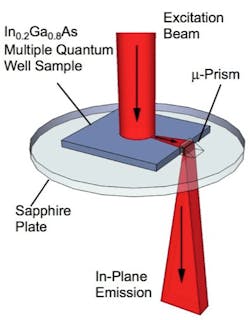Houston, TX--Researchers at Rice University, Florida State University (Tallahassee, FL), and Texas A&M University (College Station, TX) are studying spontaneous bursts of coherent superfluorescent radiation from nonequilibrium quantized electron-hole pairs in semiconductor quantum wells.1 Ordinarily, spontaneous light emission from semiconductors happens at the band edge, but the new phenomenon involves emission occurring at the quasi-Fermi edge of the carrier distribution, but then moving toward the band edge; the result is a burst of light that red-shifts during the burst. The macroscopic polarization is enhanced beyond what is possible in ordinary superfluorescence.
The quantum well consists of layers of indium gallium arsenide compound separated by barriers of gallium arsenide. The Rice University lab of Junichiro Kono created the flashes, which last on the order of picoseconds, by pumping the quantum well with 150 fs pulses; the flashes occurred 100 ps later. The researchers say the phenomenon can be understood as a combination of two previously known many-body concepts: superfluorescence, as seen in atomic and molecular systems, and Fermi-edge singularities, a process known to occur in metals. The researchers previously reported the first observation of superfluorescence in a solid-state system by strongly exciting semiconductor quantum wells in high magnetic fields. The new process—Fermi-edge superfluorescence—does not require the use of powerful magnets. This opens up the possibility of creating compact semiconductor devices to produce picosecond pulses of light.
The National Science Foundation and the state of Florida supported the research.
REFERENCE:
1. Ji-Hee Kim et al., Scientific Reports (2013); doi: 10.1038/srep03283
Source: http://news.rice.edu/2013/11/25/flashes-of-brilliance/

